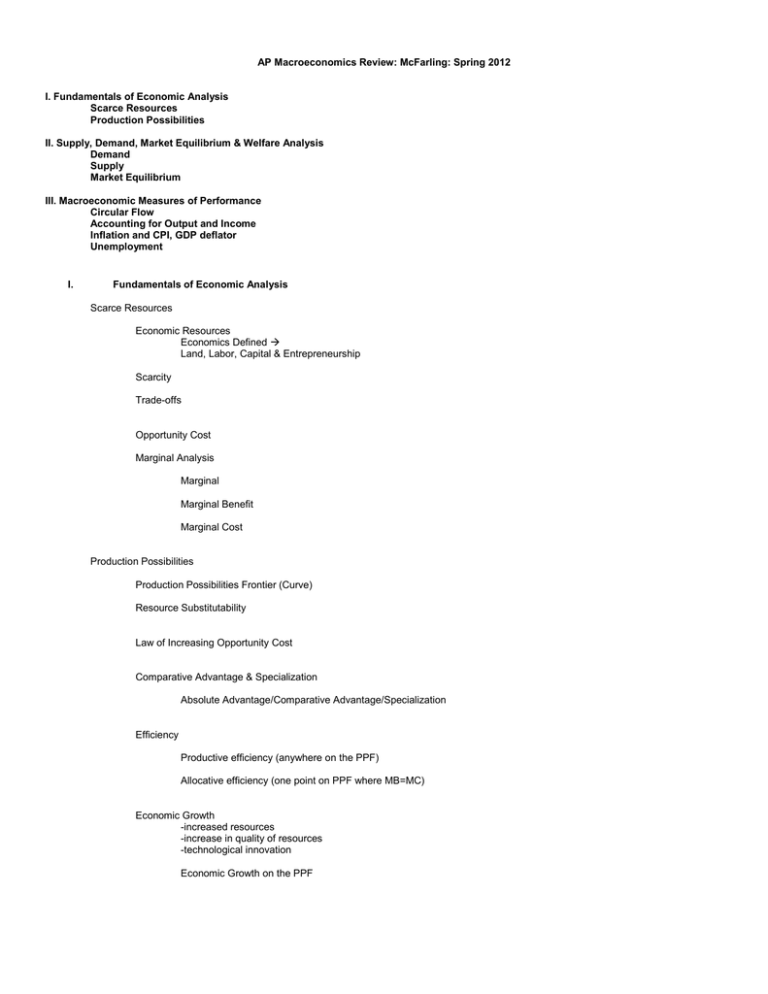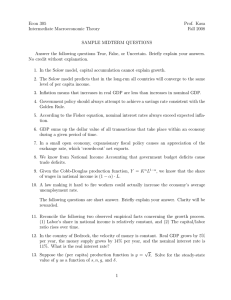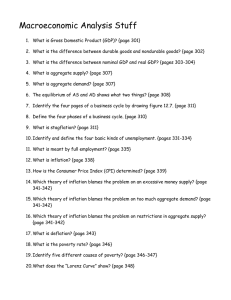AP Macroeconomics Review: McFarling: Spring 2012 I. Fundamentals of Economic Analysis
advertisement

AP Macroeconomics Review: McFarling: Spring 2012 I. Fundamentals of Economic Analysis Scarce Resources Production Possibilities II. Supply, Demand, Market Equilibrium & Welfare Analysis Demand Supply Market Equilibrium III. Macroeconomic Measures of Performance Circular Flow Accounting for Output and Income Inflation and CPI, GDP deflator Unemployment I. Fundamentals of Economic Analysis Scarce Resources Economic Resources Economics Defined Land, Labor, Capital & Entrepreneurship Scarcity Trade-offs Opportunity Cost Marginal Analysis Marginal Marginal Benefit Marginal Cost Production Possibilities Production Possibilities Frontier (Curve) Resource Substitutability Law of Increasing Opportunity Cost Comparative Advantage & Specialization Absolute Advantage/Comparative Advantage/Specialization Efficiency Productive efficiency (anywhere on the PPF) Allocative efficiency (one point on PPF where MB=MC) Economic Growth -increased resources -increase in quality of resources -technological innovation Economic Growth on the PPF II. Demand, Supply, Market Equilibrium, & Welfare Analysis Demand Law of Demand Income Effect Substitution Effect Law of Diminishing Marginal Utility The Demand Curve Quantity Demanded v. Demand Determinants of Demand - PIPEER Consumer Income Price of Substitute Goods Price of Complementary Goods Tastes and Preferences Consumer Expectations # of Buyers Supply Law of Supply/Law of Increasing Marginal Costs The Supply Curve Quantity Supplied v. Supply Determinants of Supply - CERT T/S S Cost of inputs Technology and productivity Taxes or subsidies Producer expectations Price of related outputs # of sellers Market Equilibrium Shortage Surplus Change in Demand Increase in demand Decrease in demand Change in Supply Increase in supply Decrease in supply Simultaneous Changes in Supply & Demand III. Macroeconomic Measures of Performance The Circular Flow Model – draw it Private Sector Households Firms Public Sector Government Foreign Sector Rest of the World Accounting for Output and Income GDP = C + Ig + G +Xn What’s counted? Final goods What’s not counted? Intermediate goods Underground economy Second-hand sales Aggregate Spending (Aggregate Expenditures) C = Consumption Ig= Business investment Inventories Household investment G= Transfer payments Xn= X – Exports minus M – Imports National Income Concepts GDP = C + Ig + G + Xn = Aggregate Spending = Aggregate Income (Y) Factor Payments Real and Nominal GDP Nominal GDP – Real GDPDeflating Nominal GDP to get Real GDP GDP deflator Business Cycles Expansion Peak Contraction Recession Depression Trough Inflation and CPI The Consumer Price Index Problems with CPI Inflation CPI v. GDP deflator Nominal v. Real Income Is Inflation Bad? Expected Inflation COLA Nominal Interest Rate = real interest rate + Expected Inflation Unexpected Inflation Winners and Losers Employers and Employees Variable Income and Fixed Income Borrowers and Savers Asset Price Inflation Unemployment The Labor Force Employed vs. Unemployed Discouraged Workers Self-employment Types of Unemployment Frictional Structural Full Employment Seasonal Cyclical






